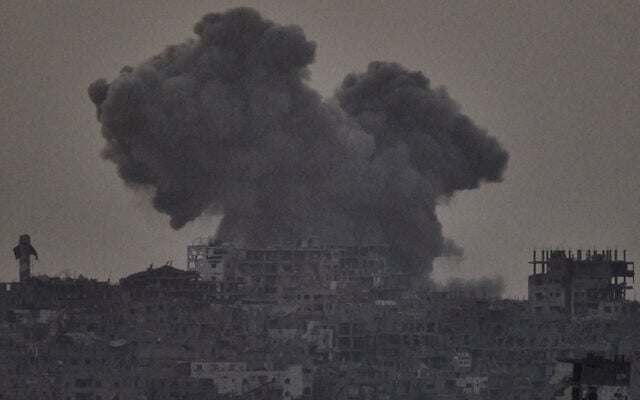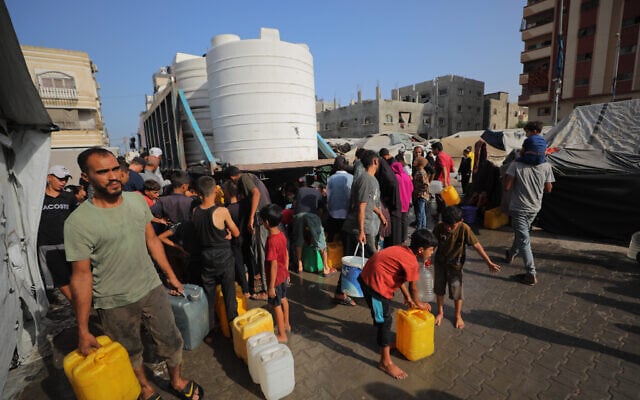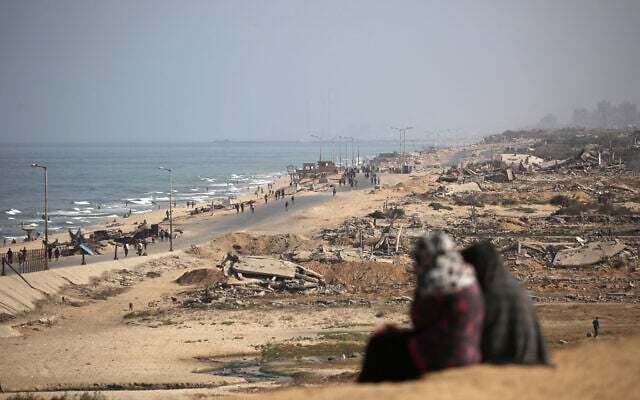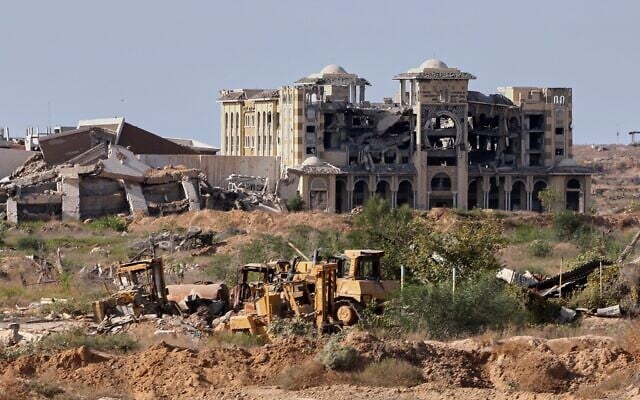

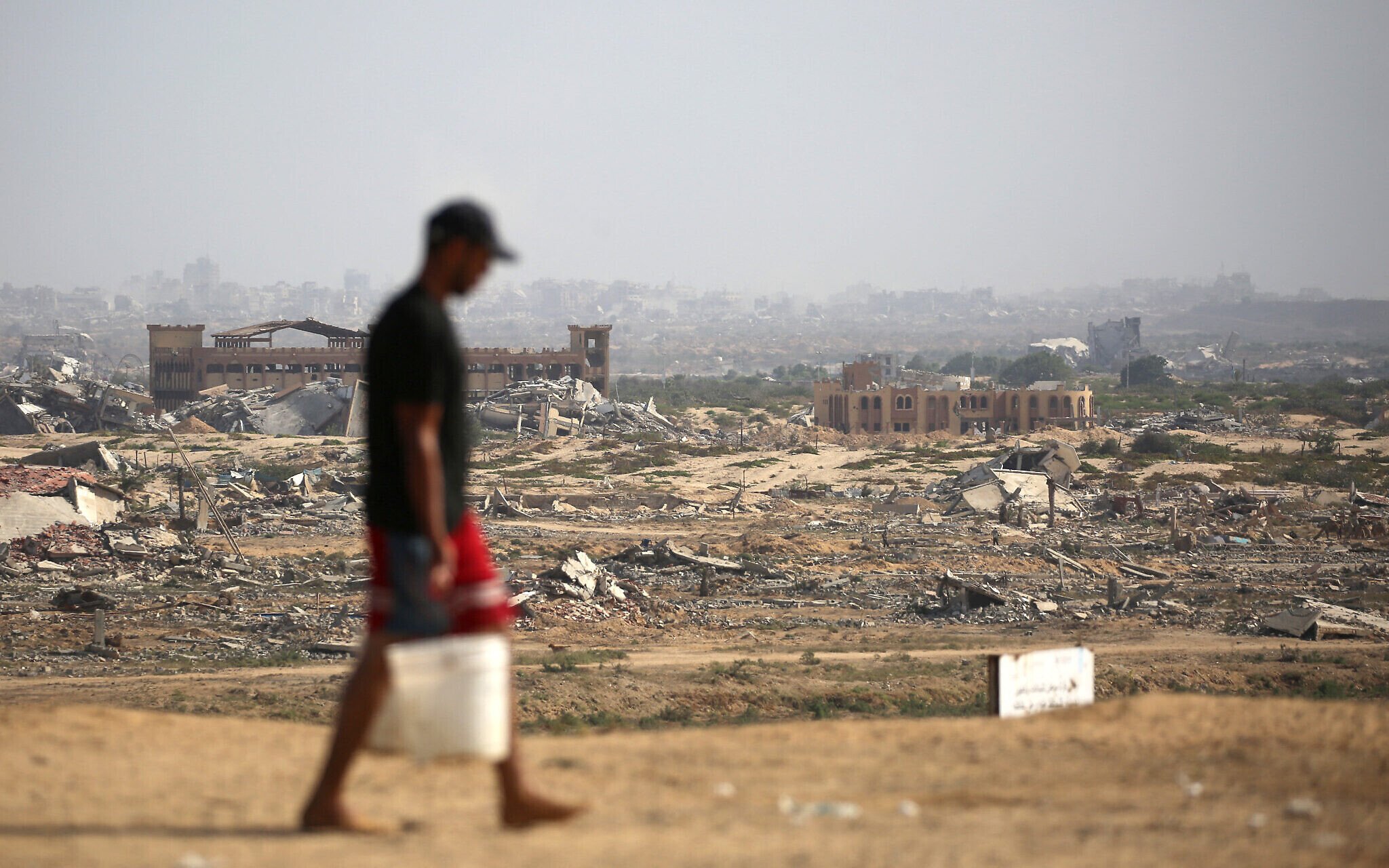
Israeli strikes in Gaza City were reported to have”significantly subsided” on Saturday, after the Israel Defense Forces was ordered to halt offensive operations there and move to purely defensive action amid a push by US President Donald Trump to bring about an end to the war.
Some residents of the city, spurred on by the news of developments in Trump’s push to end the war and the reduced military operations, took the opportunity to return to their homes on Saturday afternoon and survey the damage, ignoring the army’s warnings to avoid the “dangerous war zone.”
Still, as promised, the military continued to carry out strikes against targets it deemed to pose a threat, including in Gaza City’s Tuffah neighborhood, in which at least 18 Palestinians were reported killed, including children.
The IDF said the strike targeted a Hamas operative who “posed a threat to troops operating in the area,” and that the area had been under an evacuation warning for weeks.
The military said it took “many steps” to mitigate civilian harm, including by using precision munitions, aerial surveillance and additional intelligence information, and that it was further investigating reports of civilian casualties.
“The IDF regrets any harm to uninvolved civilians and acts to minimize such harm as much as possible,” it said.
The IDF was ordered to halt its offensive to capture Gaza City after Trump said his Gaza plan had been accepted by Hamas and called on Israel to stop bombing the Strip.
Nevertheless, the military said it was still engaged in defensive operations and warned Palestinians not to try and return to the besieged city, which it said remained a “dangerous war zone.”
In accordance with the order, troops encircling Gaza City were set to remain there, neither advancing further nor withdrawing.
To ensure the troops’ safety, the IDF dispatched additional Air Force drones to monitor the area.
Confirming as much, two Gaza City residents, meanwhile, told the Associated Press that Israeli tanks and troops had not advanced since Saturday morning, but that artillery shells and airstrikes were still heard.
“We can still see the quadcopters everywhere,” Mohamed al-Nashar said.
Shifa Hospital director Mohamed Abu Selmiyah confirmed to the AP that bombing had “significantly subsided” over the past day.
Despite the IDF’s warnings, Gazan media outlets reported on Saturday evening that a small number of residents had risked returning to their homes in the Tel al-Hawa neighborhood in eastern Gaza City.
Reports suggested that anywhere between dozens to a few hundred people returned, although it wasn’t clear if all of them intended to stay, or if they had braved a trip to visit their homes and assess the damage.
The families returning to their homes on Saturday had not left the city and had merely moved further west. Anyone who heeded the IDF’s repeated calls to leave could not yet return, as the military continued to block movement from the south northward.
Roughly a million people, or around half of Gaza’s total population, had been residing in Gaza City until the IDF ordered them to leave ahead of its ground operation there. Since then, the IDF estimates that around 870,000 Palestinians have fled the city.
Meanwhile, in southern Gaza, the Khan Younis municipality began clearing rubble from airstrikes on Saturday morning and reopening streets “to allow easier passage for the displaced,” according to a municipal statement.
As in the north, it was not all quiet in southern Gaza on Saturday, as the Palestinian Red Crescent Society said its Saraya field hospital, in the enclave’s south, had received 10 bodies and over 70 injured after Israeli strikes in the afternoon.
Artillery shelling was also carried out in an area north of Bureij in central Gaza, Palestinian media reported.
For Palestinians on the ground, there was little clarity as to what Trump’s plan for the enclave meant in real terms, even as Israel and Hamas hurried to put together delegations to negotiate the proposal’s finer details.
“We want practical implementation. We want a truce on the ground,” said Sameer Qudeeh in Khan Younis, expressing worry that the talks would break down again.
“I hope Hamas ends the war, because we are truly tired,” said Mohammad Shaat in Khan Younis, as anxious Palestinians roamed the shattered streets.
In total, the Hamas-linked Civil Defense agency said on Saturday night that Israeli bombardment had killed at least 57 people since dawn, even after a halt in defensive operations.
Mahmud Bassal, spokesman for the agency, told AFP that 40 were killed in Gaza City alone.
The figures could not be independently verified and do not distinguish between civilians and combatants.
More than 67,000 Palestinians have been killed in Gaza since the start of the war, the Strip’s Hamas-run health ministry announced on Saturday, adding that the figure had jumped above 67,000 after more than 700 names were added to the list of the dead after the relevant data was verified.
The Hamas health ministry also says that two more people died of malnutrition and starvation in the enclave, raising the reported number of deaths from such causes to 459 people, including 154 children, since the war started.
Israel has disputed claims of widespread famine in Gaza, but has previously admitted “there are issues of access to food” in some areas.
The ministry’s tally of 67,074 killed since October 7, 2023, does not differentiate between civilians and combatants, and cannot be independently verified.
Separately, the IDF said on Saturday that it had uncovered a Hamas tunnel running underneath a hospital in Gaza City and an entrance to another adjacent to a separate medical center.
The first tunnel was located next to the Jordanian Hospital, in the south of Gaza City.
According to the IDF, troops of the 36th Division, including forces of the elite Yahalom combat engineering unit, found an entrance to the tunnel at a Hamas compound adjacent to the Jordanian Hospital.
The tunnel spans a kilometer and a half, and includes a weapons manufacturing workshop and other rooms, the military said.
The IDF said that according to its intelligence, Hamas company and platoon commanders had resided in the tunnel, but that “Hamas’s activity near the Jordanian hospital was carried out without the involvement or knowledge of the Jordanians.”
The military escorted international journalists to see the location of the tunnel on Friday, in a rare — and limited — visit to the enclave that has been all but closed to press, both Israeli and international, since the war began 729 days ago.
Soldiers took the journalists to a lookout point in Gaza City’s Sabra neighborhood, several hundred meters away from the deserted Jordanian hospital.
What appeared to be a tube extended from one of its buildings into a mound of dirt in front of it, which soldiers said was where the tunnel was located. A few hundred feet away, excavators moved piles of sand, as the sound of gunfire and artillery reverberated in the background.
Surrounded by destruction and collapsed buildings, the hospital shut down about two weeks ago, after announcing that it would be moving operations out of Gaza City’s Tel al-Hawa and setting up in Khan Younis instead.
Palestinian media then reported on September 23 that IDF troops had raided the site and begun “digging operations” in the area.
Of Gaza’s 36 hospitals, 22 are no longer operational and the remaining 14 are only partially functional, according to the World Health Organization.
A soldier showed journalists videos taken from a drone that flew through the 1.5 kilometer (1-mile) long tunnel. The video showed narrow tunnels that led to rooms, one of which showed explosives lined against the wall.
A Jordanian official speaking on condition of anonymity due to the sensitivity of the matter denied that its hospital was being used by Hamas.
The second tunnel was found at the Hamad Hospital near the sea in northwest Gaza City. The army said that the tunnel runs underneath the medical center.
“The Hamas terror organization systematically operates in hospital areas, exploiting humanitarian facilities for military purposes,” the IDF said, repeating what it has stated many times before. “For years, the organization has built an underground system beneath hospitals throughout the Strip, used for weapon production and managing combat operations.”
The military added that troops were operating in the area to map out the tunnels ahead of the demolition, and were “expanding their operations to additional sites where there are indications of terror activity.”


